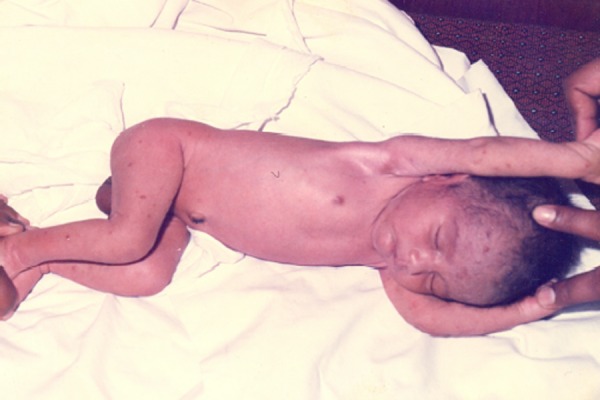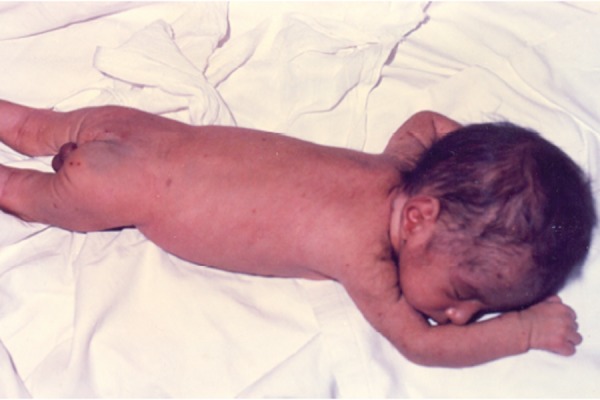Abstract
Chicken pox is an infectious childhood disease. It is rare in infants and newborns due to passive immunity received from the mother. The characteristic skin eruptions in chicken pox are vesicular with erythematous base and accompanied with pruritus. The skin of the palms and soles is typically spared. We report a case of neonatal varicella where the mother was having skin eruptions at the time of delivery and the neonate contracted it during the perinatal period and developed clinical disease on the day five of life. Specific anti-viral therapy was given to the mother and the baby and the recovery was uneventful.
Keywords: Neonatal varicella, pregnancy, congenital chickenpox
Background
Varicella-zoster virus (VZV) is a double stranded encapsulated DNA virus belonging to the Herpes virus family (human Herpes virus type 3, HHV-3).1 It is known to cause chicken pox in children and shingles and post-herpetic neuralgia in adults.1 Chicken pox is an extremely contagious rash seen in childhood and unimmunised adults where the virus spreads by airborne transmission or via fomites.2 The incubation period from exposure to appearance of rash varies from 10 to 23 days with an average of 14 days.3 The clinical course of the disease is usually mild and selfremitting except in infants and persons over 15 years of age who tend to have severe disease.5
The presentation of the newborn after intrauterine infection with varicella depends upon the time of onset of infection in the mother. Chicken pox infection of the mother is not associated with first trimester abortions. Although, infection during the first two trimesters, may result in congenital varicella syndrome, its incidence is less than 1%.4 Congenital varicella syndrome has a poor prognosis with a mortality rate of around 30% in the first few months of life. Varicella embryopathy results in microcephaly with cortical atrophy and calcifications, limb hypoplasia, cicatricial skin scars and hypo-pigmented areas and damage to the autonomic nervous system.5 Although infection during the last trimester is usually not associated with congenital varicella, the risk of disseminated varicella infection to the neonate (neonatal varicella) is highest if the mother has developed a varicella rash between seven days before and seven days after delivery.6,7 During this period, passive immunity may not have been conferred to the newborn from the mother and the infant’s cell-mediated immune response may not be enough to prevent the viremia. The infection might have been contracted by the infant in utero through the placenta or by an ascending infection or during passage through the birth canal via the respiratory tract of the infant. It is this infection contracted in between seven days pre-delivery to seven days post partum by the infant, that is described as neonatal varicella.
Case details
A male baby was born to a 24-year-old unbooked second gravida mother at full term by normal vaginal delivery in a tertiary care hospital. Mother had developed vesicular skin eruptions with severe pruritus suggestive of chicken pox three days prior to delivery.
Baby cried well soon after birth and had no dermatological lesions. His birth weight was 2.5kg, length 47cm and head circumference 35cm, all of which were within normal range for a term baby. Vital parameters revealed a normothermic baby with a heart rate of 140 beats per minute and respiratory rate of 44 per minute. There were no apparent congenital malformations. General and systemic examinations did not reveal any abnormality.
Figure 1. Neonate with lesions.

In view of varicella eruptions in the mother, perinatal infection to the baby was kept in mind and prophylactic acyclovir therapy was started soon after birth. On the fifth post natal day, discrete, shiny vesicular, unilocular eruptions surrounded by erythema were seen on the forehead, face, trunk and limbs. His palms and soles were spared. Based on maternal history typical of chicken pox and the nature of rash on the baby, a diagnosis of neonatal varicella was made. Considering that the rash appeared before the incubation period of varicella, an intra uterine infection was strongly suspected. The diagnosis was based on history and characteristic presentation. No serological or viral studies were done.
Figure 2. Characteristic lesions.

Both mother and the baby were put on supportive therapy. The baby was admitted to a neonatal intensive care unit in isolation to prevent transmission and to be able to manage any respiratory emergency. Formula feeding and expressed breast milk feeds were given to the baby to restrict contact with the mother till the mother’s lesions began crusting. Acyclovir was continued for the baby.
All rashes disappeared by 12th day after birth and their recovery was complete and the uneventful. The baby was followed up during routine immunisation visits for upto one year and there were no complications.
Patient consent
Informed written consent was taken from the parents of the child for publication of this case report, including photographs.
Discussion
Neonatal varicella is rarely encountered and treated even less.4 It is distinct from congenital varicella caused due to the intrauterine infection of the foetus. Neonatal varicella on the other hand is caused due to peri-natal infection of the neonate in a very narrow window of time. The authors agree it is a condition about which a considerable amount of literature has been compiled over the years in the form of review articles. However, since the incidence of neonatal varicella is extremely low, it is hardly taught to residents and students in medical schools. Most paediatricians too find it difficult to diagnose the condition due to the unfamiliarity with the presenting symptoms on being encountered with this condition.
Disseminated varicella in the newborn was first described by Hubbard in the late 19th century.8 Incidence of varicella has been reported to be between 0.1 to 0.7/1000 pregnancies as around 88 to 98% of the population already has anti-VZV antibodies by 20–40 years of age.9–11 Although the occurrence of neonatal varicella is quiet rare, up to 31% of infants with severe disease may succumb to it.12 Hence it is very important to initiate anti-viral therapy in the neonate at the earliest opportunity. The case reported here had a very high chance of contracting neonatal varicella since the mother had developed chicken pox within seven days of delivery. In view of the same, acyclovir therapy was initiated prophylactically which was helpful in reducing both the severity and duration of the rash in the baby.
Acyclovir and its pro-drug form valacyclovir are the drugs of choice for treatment of acute VZV infection. These drugs may be given by oral or intra venous routes depending upon the severity of the infection. Foscarnet is preferred in case of viral tyrosine kinase deficient mutant strains of VZV which are resistant to acyclovir.13 Anti-varicella-zoster immunoglobulin (VZIG) is also advocated by some researchers as the passively administered antibodies can limit the severity of infection and risk of complications such as pneumonitis.7 Extra corporeal membrane oxygenation (ECMO) may be required for neonates with severe pneumonitis and having high mortality risk.13
ACKNOWLEDGEMENTS
We thank the parents of the patient for their cooperation and consent. We also acknowledge and thank the staff of the unit where this child was treated for their help in the management of the case.
Footnotes
PEER REVIEW
Not commissioned. Externally peer reviewed.
CONFLICTS OF INTEREST
The authors declare that they have no competing interest.
FUNDING
None
CONSENT
The authors declare that
1. They have obtained informed consent for the publication of the details relating to the patient(s) in this report.
2. All possible steps have been taken to safeguard the identity of the patient(s).
3. This submission is compliant with the requirements of local research ethics committees.
Please cite this paper as: Bhardwaj AK, Sharma PD, Sharma A. Neonatal varicella: A rare case report. AMJ 2011, 4, 6, 291-293. DOI:http//dx.doi.org/10.4066/AMJ.2011.682
References
- 1.Arvin AM. Varicella-zoster virus. Clin Microbiol Rev. 1996 Jul;9(3):361–81. doi: 10.1128/cmr.9.3.361. [DOI] [PMC free article] [PubMed] [Google Scholar]
- 2.Gustafson TL, Lavely GB, Brawner ER Jr, Hutcheson RH Jr, Wright PF, Schaffner W. An outbreak of airborne nosocomial varicella. Pediatrics. 1982;70(4):550–6. [PubMed] [Google Scholar]
- 3.Grose C. Variation on a theme by Fenner: the pathogenesis of chickenpox. Pediatrics. 1981;68(5):735–7. [PubMed] [Google Scholar]
- 4.Smith CK, Arvin AM. Varicella in the fetus and newborn. Semin Fetal Neonatal Med. 2009;14(4):209–17. doi: 10.1016/j.siny.2008.11.008. [DOI] [PubMed] [Google Scholar]
- 5.Brunell PA. Varicella in pregnancy, the fetus, and the newborn: problems in management. J Infect Dis. 1992;1(166):S42–7. doi: 10.1093/infdis/166.supplement_1.s42. [DOI] [PubMed] [Google Scholar]
- 6.Lécuyer A, Levy C, Gaudelus J, Floret D, Soubeyrand B, Caulin E, Cohen R, Grimprel E. Pediatricians Working Group. Hospitalization of newborns and young infants for chickenpox in France. Eur J Pediatr. 2010;169(10):1293–7. doi: 10.1007/s00431-010-1212-9. [DOI] [PMC free article] [PubMed] [Google Scholar]
- 7.Miller E, Cradock-Watson JE, Ridehalgh MK. Strategies for the Management of Chronic Bacterial Sepsis. 8659. Vol. 2. Lancet; 1989. Aug 12, Outcome in newborn babies given anti-varicellazoster immunoglobulin after perinatal maternal infection with varicella-zoster virus. pp. 371–3. [DOI] [PubMed] [Google Scholar]
- 8.Hubbard TW. Varicella occurring in an infant twenty four hours after birth. Br Med J. 1878;1:822. [Google Scholar]
- 9.Sauerbrei A, Wutzler P. Neonatal varicella. J Perinatol. 2001 Dec;21(8):545–9. doi: 10.1038/sj.jp.7210599. [DOI] [PubMed] [Google Scholar]
- 10.Lokeshwar MR, Agrawal A, Subbarao SD, Chakraborty MS, Ram Prasad AV, Weil J, Bock HL, Kanwal S, Shah RC, Shah N. Age related seroprevalence of antibodies to varicella in India. Indian Pediatr. 2000;37(7):714–9. [PubMed] [Google Scholar]
- 11.Reynolds MA, Kruszon-Moran D, Jumaan A, Schmid DS, McQuillan GM. Varicella seroprevalence in the U.S.: data from the National Health and Nutrition Examination Survey, 1999-2004. Public Health Rep. 2010;125(6):860–9. doi: 10.1177/003335491012500613. [DOI] [PMC free article] [PubMed] [Google Scholar]
- 12.Preblud SR, Bregman DJ, Vernon LL. Deaths from varicella in infants. Pediatr Infect Dis. 1985 Sep-Oct;4(5):503–7. doi: 10.1097/00006454-198509000-00013. [DOI] [PubMed] [Google Scholar]
- 13.Arvin AM. Antiviral therapy for varicella and herpes zoster. Semin Pediatr Infect Dis. 2002 Jan;13(1):12–21. doi: 10.1053/spid.2002.29753. [DOI] [PubMed] [Google Scholar]
- 14.Reiterer F, Kuttnig-Haim M, Maurer U, Urlesberger B, Ricabbona M, Zobel G, Müller W, Dacar D. Successful treatment of therapy refractory shock lung in a newborn infant with congenital varicella using extracorporeal membrane oxygenation. Klin Padiatr. 1994;206(2):92–4. doi: 10.1055/s-2008-1046589. [DOI] [PubMed] [Google Scholar]


